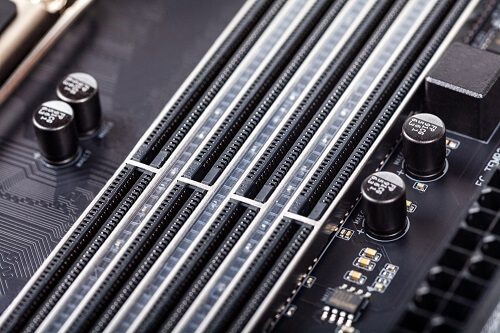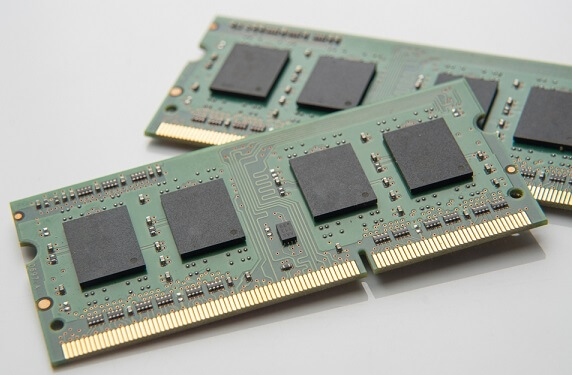When purchasing hardware to build a powerful PC, you must choose the memory wisely. Memory plays a major role in determining how powerful and faster the computer will be. In the current market scenario, you will have to choose between two sticks of RAM or four sticks of RAM. If the terms are new to you, you are not alone.
Your choice between the types of RAM can determine the speed and performance along with the multi-tasking ability of a computer. Therefore, it is important to understand the differences between 2 sticks and 4 sticks of RAMs and when you choose them for optimal performance.
Outline
ToggleWhat is 4 Sticks of RAM and How It Works?

If your motherboard and processor support the quad-channel mode, four sticks of RAM can improve the overall performance. Quad-channel mode offers greater bandwidth; hence, if you run memory-intensive programs, the performance improvement will be significant. The processor can access the four sticks simultaneously to complete the job instead of the single or dual sticks.
What are the Pros and Cons of 4 Sticks?
Here are the Pros of 4 Sticks of RAM.
- 4 sticks of RAM offer greater bandwidth. The more the number of sticks, the greater the bandwidth. Four sticks of RAM offer double the bandwidth of two sticks.
- More bandwidth helps the CPU to perform more memory-related tasks. This ensures consistent performance even when greater memory-demanding programs are running.
- 4 sticks of RAM ensure that the high-end games can run smoothly along with a powerful CPU even when your GPU is not that powerful or an external GPU is not present.
Here are the Cons of 4 Sticks of RAM.
- If your motherboard or processor does not support quad-channel mode, 4 sticks of RAM work like 2 sticks of RAM.
- You will need a high-end motherboard and CPU to support quad-channel mode; hence, the setup’s overall cost increases significantly.
- 4 sticks of RAM can improve performance only when your CPU is weaker than the GPU. Otherwise, the performance improvement will not be noticeable.
What is 2 Sticks of RAM and How It Works?

If your motherboard and processor support the dual-channel mode of memory, installing two sticks of RAM can be better than one stick of RAM in terms of performance. Dual-channel mode offers greater bandwidth, and the processor can access both the RAM simultaneously to complete different activities. This improves the overall performance of the computer.
What are the Pros and Cons of 2 Sticks?
Here are the Pros of 2 Sticks of RAM.
- 2 sticks of RAM offer dual-channel mode and more bandwidth than a single stick of RAM.
- When you use 2 sticks of RAM, your CPU can access both RAMs simultaneously and transfer data faster to boost performance.
- 2 sticks of RAM are more common in modern and mid-range motherboards. Most CPUs support dual-channel mode. Therefore, you can purchase a motherboard, CPU, and RAM well within your budget.
Here are the Cons of 2 Sticks of RAM.
- 2 sticks of RAM are not suitable for heavy-duty applications and high-end games.
- 2 sticks of RAM do not offer any performance improvement like four sticks of RAM.
- The bandwidth is better than a single stick of RAM, but it is still quite limited in comparison to 4 sticks of RAM.
What are the Differences Between the 4 Sticks and 2 Sticks of RAM?
Here are the major points of differences between 4 sticks and 2 sticks of RAM.
- Bandwidth: The major difference is that four sticks of RAM offer double the bandwidth of 2 sticks of RAM.
- Performance: Considering your motherboard and CPU support quad-channel mode, four sticks of RAM can improve performance more than two sticks of RAM.
- FPS: FPS refers to how many full-screen images are displayed per second, and four sticks of RAM can outperform two sticks of RAM in terms of FPS.
- Data Transfer Speed: Since the CPU can access four channels simultaneously, four sticks of RAM offer higher data transfer speed than two sticks of RAM.
- Hardware Configuration: 2 sticks of RAM are supported by most motherboards and CPUs, including the mid-range hardware. On the contrary, four sticks of RAM need high-end motherboards and CPUs so that they support quad-channel mode.
- Price: Considering the overall hardware cost, 4 sticks of RAM will cost you more than 2 sticks of RAM.
When to Choose 4 Sticks of RAM?
When your CPU is not as powerful as your GPU and your CPU bottlenecks your gaming experience, four sticks of RAM delivers better performance. If you are willing to pay a few bucks more for a performance boost, you should opt for four sticks of RAM. The four sticks of RAM will occupy all the available four slots, and there is no scope for expansion. Four sticks of RAM are absolutely necessary if you play high-end games and run high-end applications like video editors.
When to Choose 2 Sticks of RAM?
When your GPU is not as powerful as your CPU, installing either two sticks or four sticks of RAM will not make any significant difference. That is when choosing two sticks of RAM will give you an advantage. If you use 2x8GB rather than 4x4GB, you will have free slots to expand your computer’s memory in any future instances. Besides, two sticks of RAM are less expensive, and it is not wise to spend excess money on four sticks of RAM for a slight percentage difference in performance.
4 Sticks of RAM Vs 2 – FAQs
Ans: Yes, you can mix 2 sticks of RAM with 4 sticks of RAM. But you have to make sure they are compatible regarding frequencies and timings. However, the system may not take advantage of dual and quad-channel modes. Hence, there can be a slight decrease in overall performance.
Ans: Yes, 4 sticks of RAM can consume slightly more power than using 2 sticks of RAM. However, the difference is not significant, and it should not affect your electricity bill significantly.
Ans: If your motherboard supports quad-channel mode, 4 sticks of 8GB RAM is better than 2 sticks of 16GB RAM. If it does not support quad-channel and only supports dual-channel mode, 2 sticks of 16 GB of RAM can be better and cost you less.
Ans: Using 4 sticks of RAM can cause slight heating issues if the sticks are placed very close to one another. This is because it blocks the airflow between the memory modules. However, a proper cooling system should take care of such heating issues effectively.
Conclusion
There is always a debate between choosing 4 sticks and 2 sticks of RAM. If you are building a gaming PC with high-end hardware, four sticks of RAM are a necessity. If you are building a mid-range PC, two sticks of RAM are good enough. When you are purchasing four sticks of RAM, make sure that the motherboard and CPU support quad-channel mode so that you can enjoy the benefits of 4 sticks of RAM.

